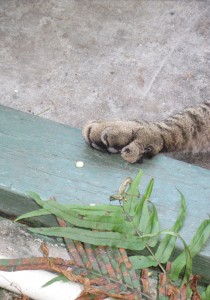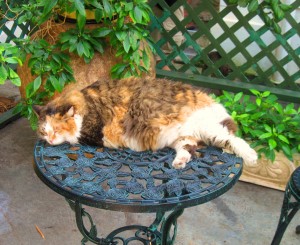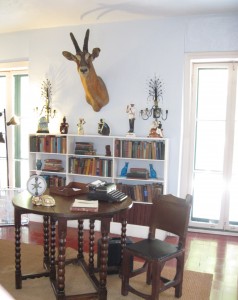In 1931, Ernest Hemingway and wife #2, Pauline Pfeiffer, bought a large house in then- out- of- the way Key West and lived there for about ten years. During this period, Hemingway wrote many of his most famous works including. A Farewell to Arms, The Snows of Kilimanjaroand others. According to the possibly apocryphal story, Pfeiffer and Hemingway’s two sons were given a six-toed cat by a ship’s captain—a photo in the house shows the boys with Snowball, the cat. As cats will, the original had kittens, many displaying the dominant polydactyl gene. Today, there are roughly forty-four cats roaming the house and grounds, sleeping on the master bed, lounging on tables, sofas and in houses set about the grounds. In each litter, some kitties have six toes per foot and others don’t. Not a single cat is shy although visitors are asked not to pick them up (patting is OK.)
The cats are terrific but so is the house that has very high ceilings, framed letters and pictures and some of the original furniture. We were told that Pauline thought the existing ceiling fans tacky and had them removed and replaced by glass chandeliers made in Murano, Italy. (I thought some of the chandeliers beyond tacky.) The large bathroom adjoining the master bedroom is said to have been the first second-floor bath in Key West with running water, obtained from a large roof-top cistern. Hemingway’s writing studio is adjacent to the house, originally accessed by “bridge” although now it’s entered via a flight of stairs. Through a metal grill, you can see the great man’s typewriter, some stuffed animal heads, books and his desk. Outside is a pool, very large for the nineteen thirties, with a penny embedded in cement next to it. Hemingway is said to have given Pauline the penny, remarking that the pool had cost him his last cent. Well, maybe not.
- Hemingway’s study
There is also a cat drinking fountain, originally a urinal at Sloppy Joe’s, a local bar Hemingway frequented. The based is covered in Italian tiles and topped by an old olive oil jar thanks to Pauline’s taste or sensibilities—your pick.
There are a lot of restaurants in Key West, several that just miss getting a 10. Flaming Buoys is sleek and produced a fabulous tuna and grapefruit cerviche, 905 serves an appetizer ‘tuna dome’ that surmounts a lot of very fresh crabmeat and a whole Thai yellowtail that was wonderful; Latitudes (read Attitudes), reached by a private ferry, is stylish with fine food, marred by less than good service.
The people of Key West refers to themselves as “Conch’s” (‘konk’, not consh) because the original settlers practically lived on conch meat, now illegal to harvest and brought in from the Caribbean. To make this recipe, substitute clams for the conch:
Conch Chowder
Ingredients:
4 large diced tomatoes
1 medium diced onion
6 small minced green onions
2 cloves garlic, minced
2 stalks diced celery
2 large diced carrots
1 chopped red bell pepper
1 medium diced potato
6-8 sprigs chopped parsley
4 sprigs fresh thyme
1/4-1/2 t ground allspice
3 bay leaves
1 16-ounce can clam juice
2 T. fresh lemon juice
2 cups cold water
1 pound cleaned and chopped conch meat (use clams)
3 slices bacon, cooked crisp and drained
1/4 cup of white wine
Juice of 1 fresh lime
salt and pepper to taste
In a large pot or stock pot, cook bacon over medium heat until browned, approximately 5 minutes.
Remove bacon, leave the grease.
Wrap allspice, bay leaves, and thyme in small piece of cheesecloth (a bouquet garni) and tie cheesecloth closed with string.
To the bacon grease, add onions, celery, carrots, potatoes, parsley, and bell peppers and cook over medium-high heat until soft, 4-5 minutes, stirring occasionally)
Add hot pepper and garlic and cook for about a minute.
Add diced tomatoes and cook for 2 minutes, stirring.
Add clam juice, water, potatoes and bring to a boil.
Add the cheesecloth with spices. Reduce the heat, and simmer, stirring occasionally, for 25 to 30 minutes.
Add the conch/clams and cook until the meat is tender (conch is very tough- clams should be done in under fifteen minutes.) Remove pot from the heat and discard the cheesecloth with spices.
Add the lime juice and parsley, stir to combine, and adjust the seasoning to taste. and serve hot. While you’re at it, give your cat a cat treat.






welcome back —
EH a great writer but i always felt him to be a detestable person — couldn’t stand him –but i understand that the Keys are delightful —
the girls were delightful as usual — –
all best,
dottie and ms mollie
Not sure about detestable but manic-depressive for sure which probably didn’t improve his personality.
Would love to have a polydactyl cat !!!! The Keys have always intrigued me–would like to visit.
Bet you can get one if you work at it. Personally, I’m happy with my two regular-toed girls. If you plan to visit the Keys, let me know –have some tips.
Mari
Polydactylism is not unique to cats. Years ago, while vacationing in the Netherlands
Antilles, we took a mail boat from St. Maarten to Saba, another small Dutch island
nearby. Saba rises from the sea without any beaches, and it’s only town, The Bottom
Is built at the bottom of the island’s extinct volcano. As our ship approached Saba,
rowboats came out to take us ashore. Once on land, we got into a waiting Land Rover
to take us into town for lunch via a narrow road that had been carved along the
volcano ‘s edge. Sitting up front next to the driver, I noticed his immense foot with
six toes, the sixth one branching out as an extra digit on his large toe. He quickly
explained that natives of Saba, for years unable to easily leave the island, had inter-
married with one another so frequently that polydactylism of hands and feet was
quite common among the island’s people, and as we soon saw, indeed it was. Now
a small airstrip has been carved at the volcanos edge and special aircraft designed
for short take offs and landings (STOL) connect Saba with it’s neighbors, and locals
now leave to find work elsewhere, and presumably, also wives.
How fascinating. It’s a dominant gene so that makes sense!
Always a treat to hear your digressions and I learn something new every time.
Thanks for keeping me in the loop. Hope all are well and thriving on “konk” soup.